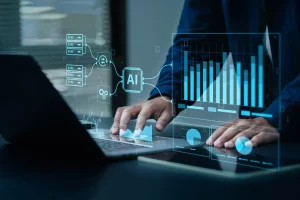AI Agents are revolutionizing Accounts Payable (AP) and Accounts Receivable (AR) management by automating repetitive tasks, improving accuracy, and optimizing cash flow. They increase operational efficiency by minimizing manual effort, reducing errors, and speeding up processes. Predictive insights from AI Agents improve decision-making, enabling smarter finance strategies and proactive problem solving.

Index
ToggleWhat are payables and receivables?
Accounts Payable (AP)
Accounts payable is the amount of money a business owes to suppliers or partners for goods or services it has received but has not yet paid for. It is a short-term liability recorded on a company's balance sheet, representing a financial obligation to be paid in the near future. Common examples include paying utility bills, office supplies, and supplier invoices.
Accounts Receivable (AR)
Accounts receivable is money that customers owe a business for goods or services that have been provided but have not yet paid for. It is an asset on the balance sheet because it represents money that is expected to be collected in the future. Examples include sales invoices and uncollected payments from customers.

Overview of accounts payable and accounts receivable management in finance
In finance, managing accounts payable and receivable is crucial to maintain a balanced cash flow and ensure stable business operations. AP handles supplier receivables, ensures timely payments, and maintains good relationships with partners, while AR focuses on collecting receivables from customers to increase cash flow. With the rise of AI Agents, both these functions are undergoing major changes.
AI systems designed to make automated, context-aware decisions improve this process by automating repetitive tasks, detecting errors, and generating predictive insights. This approach reduces errors, speeds up workflows, and allows finance teams to focus on more strategic tasks.
Additionally, AI Agents continuously learn and adapt to new data patterns, providing finance teams with up-to-date information and allowing them to respond more flexibly to financial challenges. As a result, businesses improve transparency, optimize cash flow, and strengthen relationships with suppliers and customers.
Traditional Account Management and Automated AI
| Feature | Traditional Account Management | Automated AI Account Management |
| Data Entry & Verification | Manual data entry and verification | Automate data entry and verification |
| Payment Reminder | Manual follow-up response | Predictive alerts based on patterns and due dates |
| Invoice Reconciliation | Time consuming manual process | Automated invoice reconciliation with purchase orders |
| Error Rate | High error rate due to manual processing | Reduce errors with machine learning and automation |
| Cash flow forecast | Based on historical data and manual adjustments | AI-driven predictive modeling for more accurate forecasts |
| Fraud Detection | Basic rule-based detection | Detect anomalies and prevent fraud with AI |
| Scalability | Difficult to scale with manual processes | Easily scalable with automation and AI |
| Cost Effective | High administrative costs due to manual work | Lower operating costs with automation and AI |
Cross-functional actors in accounts payable and receivable management
Main coordinating agent
The master orchestrator plays a central role in this automated receivables management system. It coordinates the activities of all the individual actors, ensuring that they work in harmony and tasks are handled smoothly. This orchestrator ensures seamless integration between the different actors, helping to optimize the entire workflow and improve operational efficiency. It also helps to predict potential liquidity issues, allowing businesses to take proactive steps to maintain adequate working capital.
Data collection and invoice processing agent
This agent collects invoices from suppliers and payment information from customers from various sources such as email, documents, or directly from the supplier's system, eliminating the need for manual data entry. It ensures that invoices are accurate, up-to-date, and automatically generated for customers according to pre-defined rules.
Payment verification and reconciliation agent
This agent verifies supplier invoices by comparing them to purchase orders and contracts to ensure accuracy before payment. It also compares customer payments with outstanding invoices, flagging any discrepancies such as partial or overpayments for further review.
Payment scheduling and debt collection agent
For accounts payable, the agent schedules timely payments to suppliers based on due dates, payment terms, and available cash flow. For accounts receivable, the agent monitors unpaid invoices and sends automated reminders to customers about due or past due amounts.
Cash flow optimizer and forecaster
This agent balances receipts and payments to maintain a healthy cash flow. It provides real-time cash flow forecasts based on expected payments and collections, tracking both accounts payable and receivable. By anticipating potential liquidity issues, this agent helps businesses take proactive steps to ensure adequate working capital and smooth operations.
Applications of AI Agents in AP and AR Management
- Automatic Invoice Reconciliation and Validation: AI Agents automatically reconcile invoices with purchase orders and delivery notes, eliminating manual verification, speeding up the approval process, and ensuring accuracy by preventing errors such as duplicate or incorrect payments.
- Optimizing Cash Flow Forecasting: Revenues and expenses are forecasted by analyzing historical financial data. Payments are planned based on available cash flow forecasts, helping businesses optimize liquidity, plan for expenses, and ensure all financial obligations are met without cash flow problems.
- Enhanced Fraud Detection: Transaction patterns are analyzed to detect unusual or suspicious behavior, such as duplicate invoices or unusual payment amounts. Potential fraudulent behavior is flagged early, allowing the finance team to intervene proactively, preventing financial losses and protecting assets.
- Automatic Payment Reminders and Tracking: Outstanding invoices are tracked and reminders are sent to customers and suppliers on time. Follow-up alerts for overdue debts ensure payments are managed efficiently, improving cash flow and business relationships.
- Automatic Error Resolution: Payments from customers are compared with outstanding invoices, flagging discrepancies such as underpayments or overpayments. Relevant staff are notified and follow-ups are triggered to quickly resolve discrepancies, speeding up the reconciliation process and improving financial accuracy.
Operational Benefits of Accounts Payable and Receivable Management
- Reduce Workload: AI Agents automate repetitive tasks like invoice processing and payment reconciliation, handling up to 80% of AP and AR workload. This reduces manual labor and allows finance teams to focus on more strategic activities.
- Improve Performance: AI improves operational efficiency by automating data entry and generating predictive alerts. These proactive alerts ensure timely actions, increasing productivity by up to 30% by minimizing delays, manual effort, and human intervention in financial processes.
- Increased Accuracy: AI-powered validation processes cross-check data and reconcile invoices, reducing human errors by up to 25%. By improving data accuracy, businesses ensure reliable financial records, minimizing discrepancies and costly errors in accounts payable and receivable management.
- Cost Savings: Automation reduces human intervention, cutting labor costs associated with AP and AR management. With fewer errors, faster processing, and streamlined workflows, companies can achieve significant savings in operational costs.
Technologies are transforming accounts payable and receivable management
- Natural Language Processing (NLP): NLP is used to interpret and extract relevant information from unstructured text in invoices, receipts, and other documents. It helps AI systems understand linguistic nuances and process data accurately without human intervention, optimizing data extraction.
- Machine Learning: Machine learning algorithms analyze historical data to identify patterns and anomalies. This allows AI to detect fraudulent activities, predict future trends, and make informed decisions. It improves over time by learning from new data inputs, increasing its accuracy and decision-making capabilities.
- Optical Character Recognition (OCR): OCR technology scans and converts text from images or scanned documents into editable, machine-readable data. It automatically extracts important information from receipts, invoices, and other paper sources, minimizing manual entry and improving data accuracy.
Future Trends of AI Agents in Account Management
- Increase Application: By 2025, AI is expected to automate up to 80% of AP and AR tasks, significantly reducing manual workload, improving processing speed, and freeing up finance teams to focus on strategic activities.
- Increase Efficiency: AI will optimize repetitive tasks like invoice processing, payment reconciliation, and receivables tracking, increasing productivity and reducing errors.
In summary, the application of AI Agents in the management of payables and receivables not only brings great operational benefits but also helps businesses optimize cash flow, increase accuracy and save costs. Investing in this technology will help Vietnamese businesses improve their competitiveness, keep up with international trends and achieve long-term financial goals.
Source: akira.ai
Monitor Bizzi To quickly receive the latest information:


